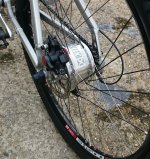knutselmaaster
1 kW
When I order I do it for an exact wheel size.cycleops612 said:I was under the impression u could opt for different gearing on geared hubs, then i was told u cant, now i hear you can.
cool u r using a 28" roadbike. i have long thought for a light rider, a drop bar roadbike ebike would be a blast - awesome power to weight (~12kg bike & 5kg XD motor or 2kg geared hub) & low road & wind friction.
I don't think that the gearing changes, I believe that it are the motor windings.
I haven't got more detailed information on this yet.
I have several 2-speed motors in stock that I ordered for 20", 24" and 26" wheels so I will certainly have more detailed information in the future.
The XD motor is less than 4kg, I think even less than 3,5kg. I still need to weigh them to get an exact answer.
Please share the link to Mr. Teakle's blog.Nelson37 said:Now we are getting somewhere.
All kits now sent with sinewave controllers!
Possible new gearset material! I have a link to Mr. Teakle's blog. Will read.
Real reasons to believe that the problems may have been solved! This motor does have real possibilities.
Knutsel, during the low speed parts of your power usage test, did you use autoshift or was the motor in low gear during these portions? There may be a real power savings as a hidden benefit.
Due to additional information I have obtained, from this point forward all comments and discussion from me about this subject will in no way reference the other vendor or his product. There is some overlap, but that other individual and his company are a separate issue that must be dealt with in other ways. Those who keep singing his praises should be ashamed of themselves.
Now what we need are some user reports, preferably long-term, about the motor with new gears and controller. This thing just might really be the game-changer it was hoped to be, almost three years ago.
I have tested the city bike with both the KT as the LS controllers, the KT has automatic shifting and the LS hasn't (at least not the one I have, I believe there are LS controllers with automatic shifting too).
This gave me a very good insight in the difference between the controllers.
And it sure is a benefit for the efficiency and thus the power consumption, as the motor runs more often at higher speeds (inside) and we all know that electric motors are less efficient at low rotation speed.
Thank you that you have came back to the essence of this topic, sharing information and experiences.
I am very busy at the moment but in the coming months I will open and compare old and new versions, heavily used ones, weigh and measure etc.
I will share the info here.


